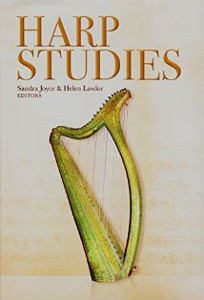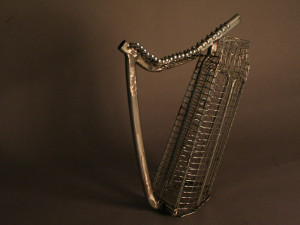
By publishing Harp Studies, Sandra Joyce and Helen Lawlor tackled the difficult task of dedicating a book entirely to the instrument with well-studied historical elements but also bringing new perspectives on a modern era often forgotten. The fourteen articles in chronological order were written by an impressive list of authors gathered around the publishers. If it begins here only in the 12th century – relaying the previous periods sometimes considered as the golden age of the harp of the Celts to the introduction of the book – one should not forget that it is not a history but rather studies devoted to the instrument.
It is therefore in 1188 that begins the journey, by one of the oldest writings referring to the Irish harp written by Giraldus Cambrensis (1188). This has been the subject of numerous previous studies and it is by a systematic approach, abundantly supported by sources, that Paul Dooley (2016) proposes his analysis of this famous quote. His research on iconography and playing techniques in the medieval period, especially from Welsh manuscripts, sets us on a genuine quest for the origins of the instrument. Without any other possibility of comparison with other descriptions of the same period, Dooley's conclusions are cautious, far from the most outlandish ideas that one has read.
At the end of the 18th century, Edward Bunting was already enthusiastic about reading this quote. He was to publish the most important collection of historical tunes of Irish music for harp, known today under his name. In her article dedicated to Bunting, Colette Moloney (2016) traces the life of this musician who was entrusted with the heavy task of saving the last vestiges of the old harp tradition at the turn of the 18-19th centuries.
In spite of the mobilization, in spite of the fund-raising campaigns such as the astonishing subscription named the Bengal Subscription by Irish philanthropic expatriates in India (M L O’Donnell 2016), despite the recruitment of teachers such as Arthur O'Neill, the various harp societies failed to revive an instrument now condemned to oblivion. Harp Studies opens then the darkest, most crucial and yet the most unknown period of the instrument: the pivotal period between the Belfast harp festival in 1792 and its revival in the 20th century.
The fate of the Irish harp then seems to escape the protagonists. The transition is assured by Harry White (2016), who skillfully illustrates in his article the transformation of an instrument which became metaphor in the works of Thomas Moore (who will popularize the collections of Bunting), William Butler Yeats and Seamus Heaney.
Moore’s ultimate icon of Irish culture became not only a symbol (Cullen 2016) but also a burden full of prejudices. Ruan O'Donnell (2016) reminds us that this vector of a fragmented community in search of stability throughout the world remains nevertheless clearly the tool of an exacerbated nationalism throughout its history. The instrument was used for identity purposes, the music also with all the possible consequences of such a phenomenon.

In the middle of the 20th century, Donal O'Sullivan published his famous book: Carolan: The Life, Times and Music of an Irish Harper (1958). Sandra Joyce (2016) warns musicians who are quick to draw from this type of publication without taking into consideration the alterations to which the originals have been subjected. The secondary orality – when the music is transmitted no longer by a musician but via an intermediate medium – of which these musicians are victims, can distort and therefore betray the author of this music.
Still, the Irish harp seems to be reborn at this time. First as an instrument primarily to accompany singing, especially that of women, whose most famous archetype remains Mary O'Hara (Lawlor 2016), then as a real musical instrument within the emerging traditional music groups (Scahill 2016). The scars of a distant past will now mark the instrument. Unlike Seán Ó Riada, for whom the sounds of the modern Irish harp move away from the historical sound (he prefered the harpsichord), a number of groups will give it its chance with the success we know today (Ceoltóirí Laighean, Chieftains, Clannad).
With one foot in tradition thanks to the historical repertoire (Heymann 2016), the other one resolutely turned towards the modern era thanks to an increasingly efficient mechanism of levers (O'Farrell 2016), it is finally the explosion of an assertive popularity, maybe a new golden age?, but this time well anchored in reality. For this harp, which has survived many centuries, evolved and recreated itself, now arouses the interest of today's composers like Eibhlís Farrell (2016) who reveals to us some secrets of her piece An chruit dhraíochta (The Magic Harp 2002), or the harpist Michelle Mulcahy (2016) between Irish music and Burmese music.

The history of the Irish Harp could have stopped there as it seems that, now, it is saved from oblivion and, better still, that its vitality leaves no doubts of its capacity to respond to current issues of the modern world. Harp Studies partly tells the tumultuous story of an instrument with the power to be reborn. The harp born from the cauldron of Dagda comes back to life in the skilful hands of a contemporary artist who, from a common supermarket trolley found in the depths of the water, causes the mythical instrument to spring forth (Lawless, NicGhabhann, Ó Súilleabháin and Phelan 2016). It's on this very positive conclusion that the book ends and the loop is completed.
Throughout the articles, the reader is faced with multiple questions. The story told here weaves uninterrupted bonds between the periods in spite of the historical events, until this last supernatural loop. It is precisely the question of the link between the modern instrument and its illustrious ancestor that regularly confront the harpists of today. If the ambition of Harp Studies was not to answer precisely this question, the reading of this book will certainly allow them to find some partial answers.